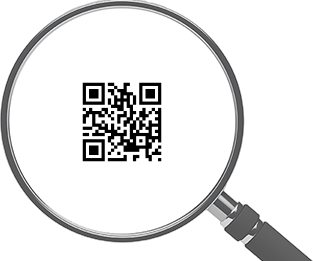What is QR Code?
QR Code is a two-dimensional (matrix) barcode format initially developed, patented, and owned by Toyota subsidiary Denso Wave for car parts management; it is now in the public domain. The “QR” is derived from “Quick Response”, as the creator intended the barcode to allow its contents to be decoded rapidly. It can store up to 2,335 ASCII characters in one barcode symbol and includes Error Correction Code (ECC) which allows error-free reading even when a symbol has been partially lost or destroyed.
The QR Code consists of black modules arranged in a square pattern on a white background. The information encoded can be text, URL, or other data. Its components include quiet zone, finder patterns, alignment patterns, timing patterns, version information, data cells, and error correction.
- Quiet zone: A blank white border to isolate the code from other printed information.
- Finder patterns: Large black and white identical squares in the corners, except for the bottom right corner. The finder patterns enable the decoder software to recognize and determine the correct orientation.
- Alignment pattern: This ensures the code can be deciphered even if it's distorted.
- Timing pattern: The timing pattern consists of altering black and white modules that run horizontally and vertically between the three finder patterns. The timing pattern makes it easy to identify the individual data cells and is especially useful when the code is damaged or distorted.
- Version information: There are various versions of this standard. The version information simply identifies which version is being used in a particular code.
- Data cells: Each individual black or white square that is not part of one of the standard features (the timing, alignment, and other patterns) contains data in the code. Data is stored in 8-bit parts, called code words, in the data cells.
- Error Correction: A portion of the data stored in the barcode is devoted to Error Correction Codewords or ECC; this sophisticated technology is used to detect and correct errors as well as help recover lost data (known as erasures).
Why use a QR Code?
QR Code is readable from any direction. The alignment patterns at the three corners of the image enable rapid reading, while the timing pattern allows for the code to be read even if distortion or damage has occurred.
Advantages include:
- More Information: They efficiently pack more information in a smaller space as opposed to one-dimensional (1D) barcodes. Each barcode can store up to 7,089 values.
- Fewer Errors: They employ much more robust error correction technology than traditional 1D barcodes; in addition to having built-in error-checking systems, they may still easily be detected and read if damage has occurred.
- Easily Read: They are easily read with any smartphone.
- Greater Security: They provide greater security than 1D barcodes, due to their ability to encrypt information.
Who uses QR Code?
Originally used in the automotive industry to track automobile parts, the QR Code has now become nearly commonplace in consumer marketing. Directing consumers to a brand Website with a single scan and offering product loyalty rewards and coupons in exchange for gathering analytics it's seductive to consumers looking for product knowledge. In addition to consumer marketing, it's utilized for product and time tracking, item identification, and document management.
How do we help developers using QR Code?
The Cognex Mobile Barcode Scanner SDK supports QR Code detection, enabling developers to gather relevant workflow and application data. You can download the SDK for free by registering on the Cognex Mobile Barcode Developer Network. Packaged with the consumer product barcodes of EAN, UPC, PDF417, and GS1 Databar, the SDK Consumer Developer License (CDL) lets you deliver a powerful retail experience quickly and easily. In addition, the Barcode Scanner SDK supports a broad range of symbologies to meet your growing development needs.

